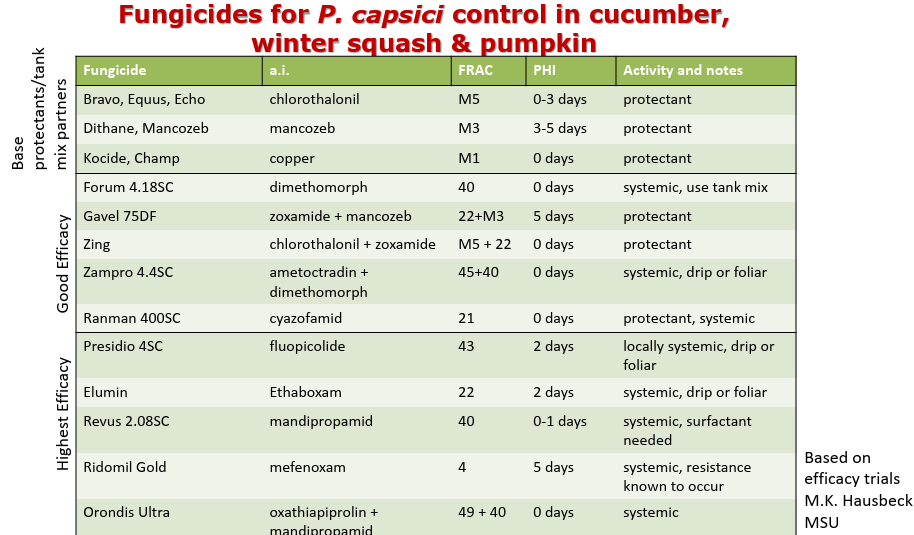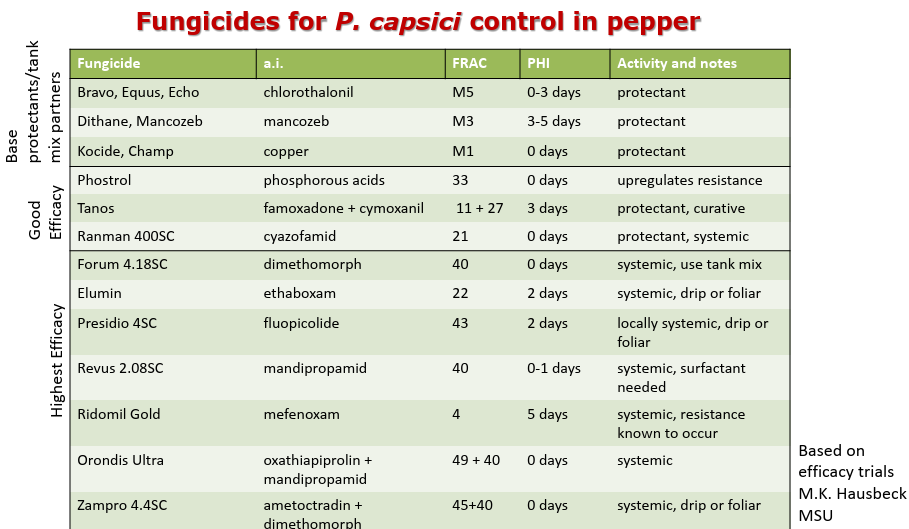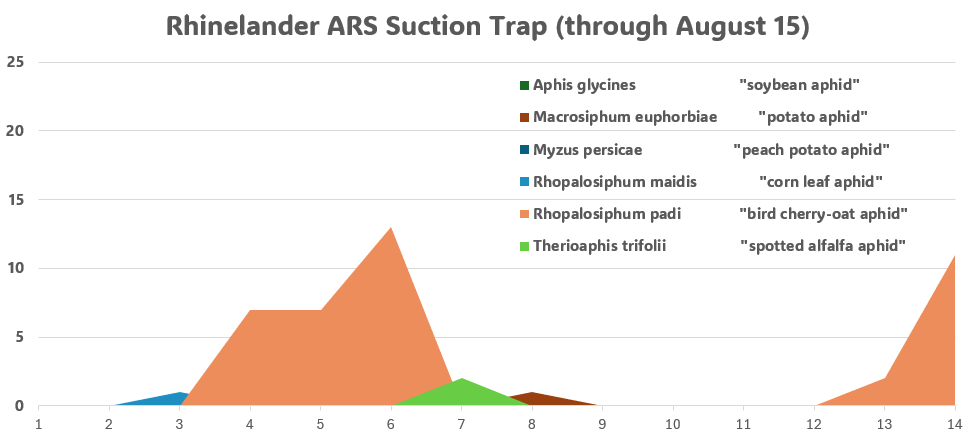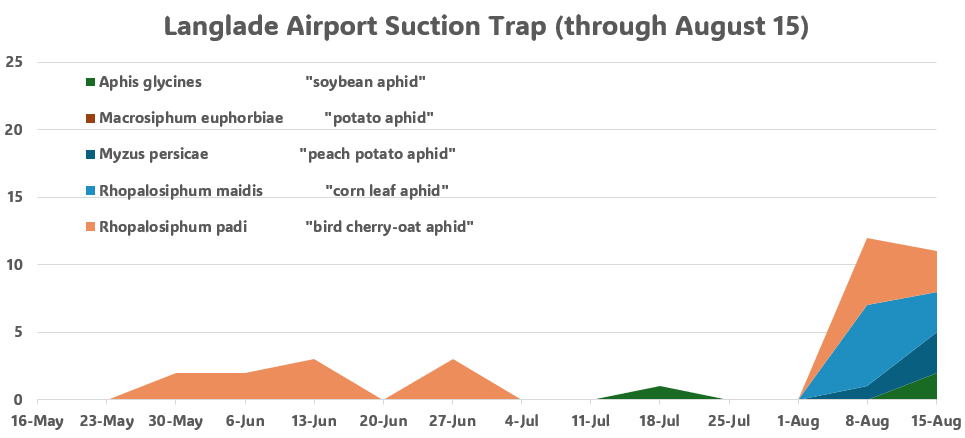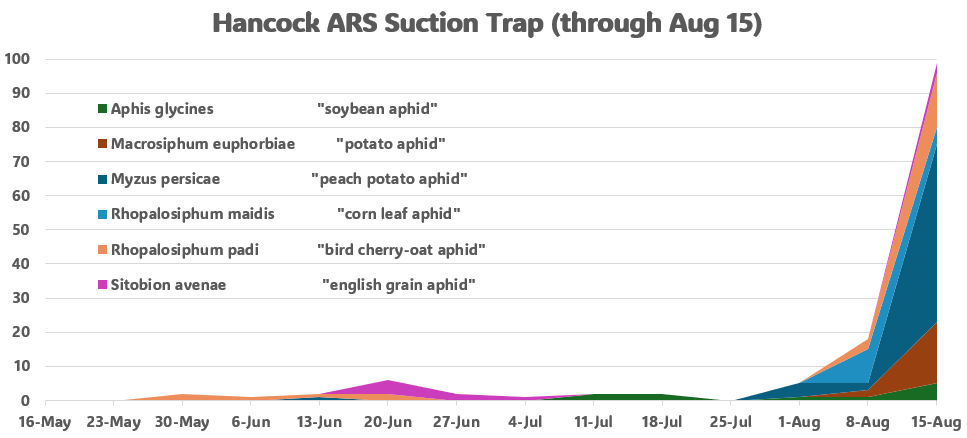
In This Issue:
- Disease forecasting updates for potato early blight and late blight
- Cucurbit downy mildew updates
- Phytophthora crown and fruit rot in cucurbits and solanaceous crops
- Corn earworm and its management
- PVY and its management
Amanda Gevens, Professor & Extension Vegetable Pathologist, UW-Madison, Dept. of Plant Pathology, 608-575-3029, gevens@wisc.edu, Lab Website: https://vegpath.plantpath.wisc.edu/.
Current P-Day (Early Blight) and Disease Severity Value (Late Blight) Accumulations will be posted at our website and available in the weekly newsletters. Thanks to Ben Bradford, UW-Madison Entomology for supporting this effort and providing a summary reference table: https://agweather.cals.wisc.edu/thermal-models/potato. A Potato Physiological Day or P-Day value of ≥300 indicates the threshold for early blight risk and triggers preventative fungicide application. A Disease Severity Value or DSV of ≥18 indicates the threshold for late blight risk and triggers preventative fungicide application. Data from the modeling source: https://agweather.cals.wisc.edu/vdifn are used to generate these risk values in the table below. I’ve estimated early, mid-, and late planting dates by region based on communications with stakeholders. These are intended to help in determining optimum times for preventative fungicide applications to limit early and late blight in Wisconsin.
|
|
Planting Date | 50% Emergence Date | Disease Severity Values (DSVs)
through 8/23/2025 |
Potato Physiological Days (P-Days)
through 8/23/2025 |
|
| Spring Green | Early | Apr 5 | May 10 | 60 | 844 |
| Mid | Apr 18 | May 14 | 60 | 816 | |
| Late | May 12 | May 26 | 57 | 759 | |
| Arlington | Early | Apr 5 | May 10 | 46 | 846 |
| Mid | Apr 20 | May 15 | 46 | 809 | |
| Late | May 10 | May 24 | 43 | 773 | |
| Grand Marsh | Early | Apr 7 | May 11 | 61 | 826 |
| Mid | Apr 17 | May 14 | 61 | 807 | |
| Late | May 12 | May 27 | 61 | 752 | |
| Hancock | Early | Apr 10 | May 15 | 60 | 795 |
| Mid | Apr 22 | May 21 | 60 | 769 | |
| Late | May 14 | June 2 | 60 | 714 | |
| Plover | Early | Apr 14 | May 18 | 49 | 771 |
| Mid | Apr 24 | May 22 | 49 | 763 | |
| Late | May 19 | June 7 | 49 | 671 | |
| Antigo | Early | May 1 | May 24 | 56 | 730 |
| Mid | May 15 | June 1 | 56 | 695 | |
| Late | June 1 | June 15 | 451 | 609 | |
| Rhinelander | Early | May 7 | May 25 | 38 | 704 |
| Mid | May 18 | June 8 | 38 | 628 | |
| Late | June 2 | June 16 | 34 | 587 | |
Late blight of potato/tomato. I’m aware of no new reports of late blight in the US this past week. Findings thus far in potato and tomato have been confirmed as US-23 Phytophthora infestans (still sensitive to mefenoxam/metalaxyl (ie: Ridomil). Here in Wisconsin, we saw accumulations of 7-13 DSVs across WI this past week. All plantings of potatoes in Wisconsin have surpassed the Blitecast threshold of 18 DSVs and should receive preventative fungicides for the management of late blight. Please find a fungicide listing for Wisconsin potato late blight management: https://vegpath.plantpath.wisc.edu/documents/potato-late-blight-fungicides/
Early blight of potato. Accumulations of P-Days were 63-68 over the past week, with P-Day 300 thresholds met for preventative fungicide treatment in potatoes across all of Wisconsin. This time of the year is tough for specific scouting as there are several diseases which may be at work along with natural crop tip and maturation. https://vegpath.plantpath.wisc.edu/diseases/potato-early-blight/. For Wisconsin-specific fungicide information, please refer to the Commercial Vegetable Production in Wisconsin (A3422), a guide available here: https://cropsandsoils.extension.wisc.edu/articles/2025-commercial-vegetable-production-in-wisconsin-a3422/
For custom values, please explore the UW Vegetable Disease and Insect Forecasting Network tool for P-Days and DSVs across the state (https://agweather.cals.wisc.edu/vdifn). This tool utilizes NOAA weather data. Be sure to enter your model selections and parameters, then hit the blue submit button at the bottom of the parameter boxes. Once thresholds are met for risk of early blight and/or late blight, fungicides are recommended for optimum disease control. Fungicide details can be found in the 2025 Commercial Veg. Production in WI Extension Document A3422: https://cropsandsoils.extension.wisc.edu/articles/2025-commercial-vegetable-production-in-wisconsin-a3422/
Cucurbit Downy Mildew: No downy mildew was seen on cucurbits this past week at HARS, and none reported through our UW Plant Disease Diagnostic Clinic. The basil downy mildew that I reported on July 27 at Hancock ARS has not advanced from the lower plant canopies. The downy mildew work of Dr. Mary Hausbeck at Michigan State University is relevant to WI https://veggies.msu.edu/downy-mildew-news/. This season, Clade 2 downy mildew spores were confirmed in several MI counties and downy mildew has been confirmed in commercial cucumber fields and home garden plots in several MI counties. New reports were posted from NY and PA at the Cucurbit Downy Mildew ipm PIPE website: https://cdm.ipmpipe.org/.
Disease profile: Phytophthora Crown and Fruit Rot of Cucurbit and Solanaceous Crops
Phytophthora blight / crown rot is a water mold or oomycete disease of several fruiting vegetable crops including cucurbits (cucumber, melon, squash), solanceous plants (tomato, eggplant, pepper), and to a lesser extent, legumes (snap beans, lima beans) caused by Phytophthora capsici. It causes large, irregular brown spots on leaves, which expand and coalesce in warm and wet conditions. On vines, water-soaked, dark lesions can girdle the stem and cause whole-plant wilt and collapse. Phytophthora capsici also causes damping-off in cucurbits, rotting the crown and root tissues and most often resulting in plant death. Fruit rot often occurs on the side of the fruit touching the soil, beginning as a water-soaked lesion that expands and is covered with white sporulating pathogen growth.
Primary Source: Infested soil and infected plant debris
Spread: Sporangia spread via very local wind currents and workers/equipment, while swimming zoospores spread via saturated soil and splashing water; the spores (sporangia) cannot travel long distances
Favorable Conditions: Warm temperatures and high humidity, high leaf wetness, high precipitation and irrigation, poorly draining soil


Infection & Disease Cycle. Phytophthora capsici can overwinter in the soil as oospores, surviving for several years (>20 years). Warmer temperatures and splashing precipitation/irrigation allow spores in the soil to come into contact with nearby plants. These spores can also travel longer distances when infested soil is transported by workers and equipment. After initial infection, lesions on the plant can bear another aerial spore type known as a sporangium. In saturated soil and warm temperatures, P. capsici can also release swimming zoospores. These zoospores infect the roots and crown of the plant, as well as lower leaves and fruit by splashing water. The pathogen can infect crops several times through a growing season, and remain in the soil after harvest. The disease can also continue to be active post-harvest causing breakdown of cucurbit or solanaceous crop fruits. Moisture and airflow management is critical to maintain healthy produce.
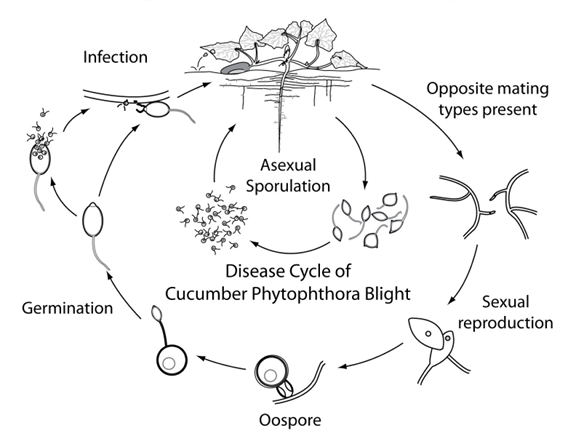
Cultural Control. Scouting regularly allows early identification of disease before significant spread and damage. The following practices can also help prevent disease development:
- Rotate away from susceptible crops ( >3 years)
- Plant resistant varieties when possible
- Plant in areas with well-draining soil
- Disinfest tools and equipment
- Maintain proper soil moisture
- Mulch with straw or dropped cover crops to reduce splash
- Destroy infected plant debris
- Do not irrigate from retention ponds that may receive run-off from infested fields (swimming spores can be present in the water and inoculate fields)
Chemical Control. Phytophthora capsici populations are known for developing resistance to fungicides when used over time. In particular, many populations have resistance to phenylamides such as metalaxyl or mefenoxam. For Wisconsin-specific fungicide information, refer to the Commercial Vegetable Production in Wisconsin (A3422), a guide available through the UW Extension Learning Store website. Or, for home garden fungicide recommendations, see Home Vegetable Garden Fungicides (D0062), a fact sheet available through the UW Plant Disease Diagnostic Clinic website. Always follow label directions carefully.
Resources/References
- Commercial Vegetable Production in Wisconsin (A3422) from the UW Extension Learning Store. This guide offers the latest recommendations for disease, insect, and weed management in Wisconsin’s most common commercial vegetable crops. Also included are lime and fertilizer recommendations as well as insect identification information and keys.
- UW Plant Disease Diagnostics Clinic. The University of Wisconsin-Madison/Extension Plant Disease Diagnostics Clinic (PDDC) provides assistance in identifying plant diseases and provides educational information on plant diseases and their control.
- Scheufele, S., and G. Higgins. 2015. “Phytophthora Blight.” Text. Center for Agriculture, Food, and the Environment. January 6, 2015. https://ag.umass.edu/vegetable/fact-sheets/phytophthora-blight.
- Schuh, Marissa, and Michelle Grabowski. 2022. “Phytophthora in Vegetable Crops.” 2022. https://extension.umn.edu/disease-management/phytophthora.
Vegetable Insect Update – Russell L. Groves, Professor, UW-Madison, Department of Entomology, 608-262-3229 (office), (608) 698-2434 (cell), e-mail: rgroves@wisc.edu. Vegetable Entomology Webpage: https://vegento.russell.wisc.edu/
Corn earworm – (https://vegento.russell.wisc.edu/pests/corn-earworm/)
Second generation of the corn earworm has increased rapidly over the past 10-14 days in southern Wisconsin. Pheromone captures (as reported from the Wisconsin Home Pest Survey) continue to confirm significant numbers of adult moths over the past two weeks in select locations in the southern half of the state. These captures will likely continue over the coming week, especially with moderate temperatures forecast. In northern portions of the state, expect increased captures over the next 10-14 days.
Insecticides must be present on vulnerable silks when eggs hatch. The first application is the most critical and tank-mixes containing an ovicide (an egg killer) and a larvicide (eg. spinosad, spinetoram, chlorantraniliprole) are recommended. On sweet corn, treat every 3 to 5 days beginning when silks first appear and continuing until they are brown in color. Discontinue treatments 10 days before harvesting fresh market sweet corn as additional sprays will not improve product quality.
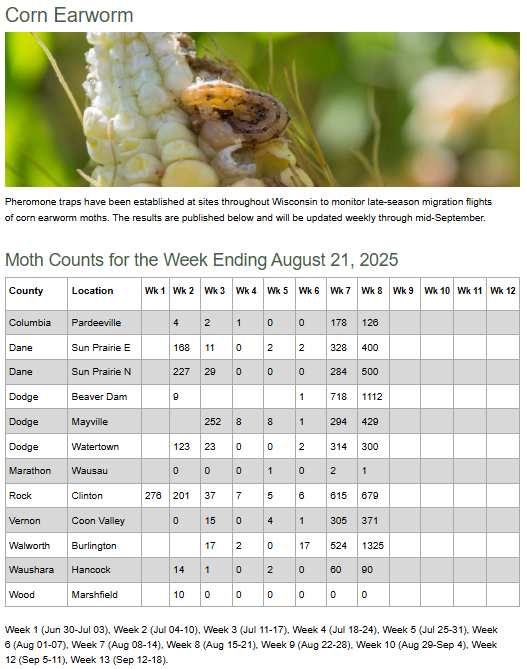
Select an insecticide with residual activity of a few days, such as the synthetic pyrethroids. For optimal coverage, set spray pressure that will deliver sufficient volume of finished spray and directed at the ear zone from each side of the row. Remember, some corn earworm larvae in the Midwest have been confirmed to be resistant to synthetic pyrethroid insecticides, signaling that this insecticide may cease to be an effective means of control. It is important to monitor the response of earworm populations after applications and adjust product selection accordingly.
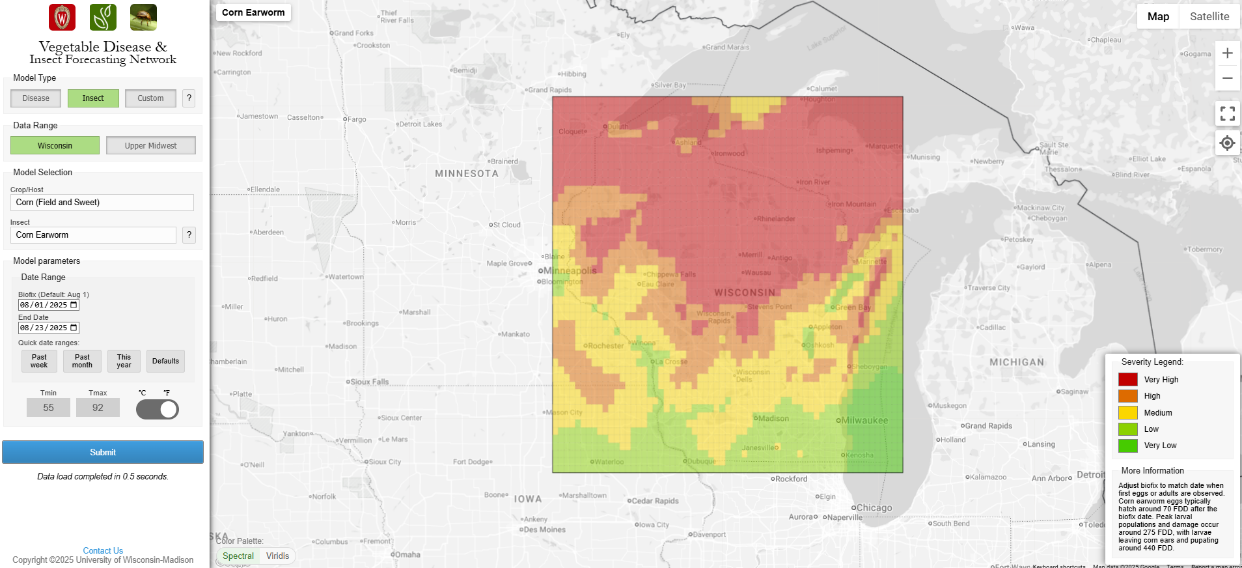
Potato virus Y and management. Aphid species that colonize potatoes (Green peach aphid (GPA) and Potato aphid (PA)) continue to be observed in fields over much of central and northern potato production areas. Increasing numbers of wingless, potato colonizing aphids (GPA and PA) have been detected in central (Adams, Columbia Portage, and Waushara) and northern (Langlade) counties, and these colonists are proportionally much higher in central Wisconsin. The Aphid Suction Trap Network reported first captures of GPA in mid-July, but throughout early August the numbers of actively flying insects have increased in Hancock and Langlade suction traps over the past two weeks. This activity is very consistent with the peak of risk as described by the Aphid Flight Risk model and displayed at the Vegetable Disease and Insect Forecasting site.
At the Langlade County Research Station, aphid captures from the suction trap network illustrate expected and modeled flight activity of GPA, bird cherry-oat aphid (Rhopalosiphum padi), corn leaf aphid (R. maidis) and soybean aphid (Aphis glycines) at this time of year. Similarly, the Rhinelander suction trap illustrates increased flight activity of a similar set of aphids. Notably, the activity of aphids in central Wisconsin is more diverse and in greater numbers. This activity in Hancock likely results from much larger populations of aphids developing across a range of processing crops and potato, as well as less intensive aphid management in this region compared to the seed growing regions of Langlade County!
